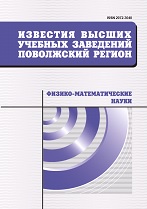|
|
University proceedings. Volga region. Physical and mathematical sciences, 2015, Issue 1, Pages 168–182
(Mi ivpnz314)
|
 |
|
|
This article is cited in 2 scientific papers (total in 2 papers)
Physics
Dimer in the Hubbard model
A. V. Silant'ev
Mari State University, Yoshkar-Ola
Abstract:
Background. Exactly solvable models are of great importance in quantum physics, as most models in quantum physics are not exactly solvable. The detailed analysis of exactly solvable model's behavior can be made by exact solutions. The solutions of exactly solvable models, obtained by the approximation method, can be compared with exact solutions, used as standards. A dimer in the Hubbard model is an exactly solvable model. The purpose of this paper is to compare exact solutions obtained for a dimer in the Hubbard model, with solutions obtained for a dimer by approximation of static fluctuations. Materials and methods. In this study, to construct exact solutions and solutions in approximation of static fluctuations the authors used the method of motion equations for creation operators, the method of Green's functions and the spectral theorem. The energy spectrum of a quantum system can be calculated by Green's functions, as the poles of Green's functions correspond to the energy spectrum of a quantum system. Knowing the Green's functions, the spectral theorem allows to calculate the correlation functions of the quantum system. Results. Resulting from the usage of the methods of the quantum field theory there were obtained anticommutator Green's functions for a dimer, that were both exact and in approximation of static fluctuations. Using the anticommutator Green's functions the authors obtained correlation functions and the energy spectrum for a dimer. Conclusions. This work demonstrates that the energy spectrum of a dimer is split by a strong Coulomb repulsion of electrons on two Hubbard subbands and the “metal-insulator” transition occurs in a dimer. This work also demonstrates that several energy states of a dimer, obtained by the approximation of static fluctuations, coincide with energy states of a dimer, obtained by an exact solution.
Keywords:
Hubbard model, Green's functions, energy spectrum, dimer, nanosystems.
Citation:
A. V. Silant'ev, “Dimer in the Hubbard model”, University proceedings. Volga region. Physical and mathematical sciences, 2015, no. 1, 168–182
Linking options:
https://www.mathnet.ru/eng/ivpnz314 https://www.mathnet.ru/eng/ivpnz/y2015/i1/p168
|

| Statistics & downloads: |
| Abstract page: | 69 | | Full-text PDF : | 24 | | References: | 25 |
|




 Contact us:
Contact us: Terms of Use
Terms of Use
 Registration to the website
Registration to the website Logotypes
Logotypes







 Citation in format
Citation in format 
